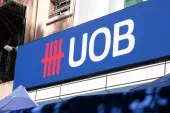
Siam Commercial Bank's FEVP Vish Jain talks about the power of digital in wholesale banking
He also reveals how digitisation is vital to improving customer experience.
Vish Jain is the first executive vice president and head of new business and operating models at Siam Commercial Bank. He has been a leader of digital transformation at Siam Commercial Bank in Thailand for the last 2 years. Before joining SCB, he spent 18 years in consulting with BCG, Marakon and Stern Stewart where he helped several banks and insurance firms to transform their business and operating models through better design technology and analytics.
Why is SCB digitizing its wholesale banking activities?
In most bank, retail is naturally the focus of digitisation efforts. In wholesale banking, there is an almost religious belief in power of relationship, and therefore less focus on technology. However at SCB, we believe there are three good reasons why wholesale banking benefits from digitisation.
Firstly, digital allows us to deliver consistency of advice to all customers’ given range of experience, quality and focus in that is inevitable amongst relationship managers. Secondly, digital allows us to create different experiences on a common infrastructure to deal with incredible diversity of needs of wholesale clients. Finally, digital can make efficient “boring” but critical to customer experience processes like onboarding, account opening, switching.
That said, most of the benefits accrue for smaller customers, from SSME to mid-corporate/commercial clients and less to jumbo/multinational corporates, but this is where large volumes and numbers are.
How are you approaching digital transformation in wholesale banking?
We took a perspective on how customers want to experience banking and divided the journey into five steps which we are digitising to various degrees:
• Prospecting. Give me value before I become your customer. When you come to see me, have something concrete for me.
• Advice and sales. Understand my business and recommend tailored solutions with clear proof of returns on investment.
• KYC, onboarding, and switching. Make it painless for me to start doing business with you.
• Payments and daily transactions. Ensure my daily banking experience is smooth and frictionless.
• Administrative service. Allow me to change things digitally as much as possible; or otherwise respond rapidly to my requests.
So how are you improving prospecting through digital?
The key here is moving from primary reliance on RMs’ personal networks to something more systematic to improve both quantity and quality of leads.
First, for businesses with fewer than 20 employees, we launched an ecosystem called Businesslinx to help customers improve their businesses, and get access to lower cost supplies. In three months, we have onboarded 30,000 SSMEs, of which 30% are new to the bank and 60% were embedded in our retail business and not previously recognised as small business customers. This platform allows us to know our customer behaviour better and be more precise with our offers.
Secondly, we are getting better at identifying underserved customers using network analysis to find non-customers closely linked to our customers, or customers that look very much like our best customers but have small relationships with us.
For bigger commercial companies, where there is sufficient third party data, we pre-run our strategic filters, KYC and credit scoring models to pre-qualify credit for high potential customers, so RMs can approach them with a concrete offer on the first meeting.
The RM is still the centre of executing the customer leads, but now the leads she gets are higher quality and she has better tools to convert them.
How is digital helping RMs in delivering advice?
The key to consistent advice is a structured advisory process called SCB Rubik which we divide into “understand”, “analyse”, “recommend”, and “sell” steps, after which, the journey proceeds into onboarding.
We want to ensure all our RMs had a consistent level of industry understanding. So we get a few industry experts to create digital “learning capsules” that combine industry facts, trends, value drivers and key financial ratios so even a junior or generalist RM can develop expertise rapidly, on demand.
The second step is to analyse the client situation versus their peer to understand where we can bring quantifiable value, through a benchmarking tool based on third-party data integration which diagnoses working capital, capital structure, FX exposures, and so on and value to customers from close the gaps.
For the recommend and sell stage of the journey, we are creating product pricing and bundling capabilities where RM can interactively play around with product assumptions and pricing with clients. This would have taken days of back and forth in the past.
Using SCB Rubik, we have acquired more commercial customers in one year than we did in this segment over the previous four years put together. The RM remains central to the customer experience, but we have made it easy for her to become an expert in the industry and provide tailored advice to the customer.
New regulations make onboarding a new client very tedious. How are you using digital here?
Yes, we believe that KYC, onboarding, and switching are often neglected moments of truth for customers, and the regulatory burden on them is increasing.
Our old KYC process was partly manual and could easily take 90 minutes for a small customer, and days for complex ones. The result was a terrible customer experience – often the first real experience the customer had with us. We’ve now created a new, digital KYC which takes 3 minutes. All a teller needs to do is enter the company’s jurisdic ID and the system basically pulls external and internal data to take care of form prefilling, UBO tracing, sanctions checking, and KYC score calculation.
Activating a new product use to require lots of paperwork with unique requirement for each product. We took tedium out of onboarding through digital forms, third-party data integration for prefilling forms and fetching documents, unified terms and conditions across products, and reuse of archived documents. Digital onboarding for our three highest volume products (CA, SA and Cheques) went live in November 2017. A customer now can get an account number within 15 minutes of meeting an RM in their office, and very shortly we will be able to onboard all our products, including our corporate digital banking portal solution in the same process.
The next frontier is the switching and setup process, which is intrinsically tedious. A large company could have hundreds of suppliers, thousands of payroll employees, and dozens of accounts with different authorizers; even a small company could have quite a few. These details could be on paper, excel spreadsheets, accounting software, or on competitors’ banking portals. We are designing a digital switching process to work with universal convertors that integrate with all sorts of formats and accounting software, screen scraping robots etc. to take the tedium out of switching. We are also creating self-switching tools so smaller customers can serve themselves.
How have you designed your corporate portal given the vastly different needs of different segments?
The needs to customers vary a lot by size. Small SSME need little more than a retail app, where large customers want to deal with dozens of users with different access right, and thousands of employees, customers and supplier and large payment sizes. So, in the interest of customer centricity, but at the risk of complexity, we have created three digital banking platforms for our business clients. However, the attempt has been to utilize common APIs and underlying infrastructure as much as possible.
Our SSME platform takes all the features of our retail app, but adds higher limits, bulk payments, and payroll and is integrated with Businesslinx ecosystem I talked about before. This platform was launched end of November 2017, with a full commercial scale-up in early 2018. For SME and commercial customers, we are creating a multi-product corporate portal which will combine BCM, trade, FX, and credit servicing in one place with omni-channel access. This will be launched by mid 2018. For the largest customers, we will continue with our legacy systems given their stability and the level of customisation and host-to-host connectivity that is already in place for these customers.
You seem to have achieved a tremendous amount in eighteen months. What are some of the lessons learnt?
The first, and perhaps the most important lesson was to create a dedicated digital transformation group, of which I am a part of, which is comprised of ex-consultants and bankers. We are business experts primarily, but unencumbered by day-to-day KPIs, and schooled in agile, business analytics, fintech, and modern architecture. We act as the conduit between the business and the world of technology and handle all design and agile-at-scale management of these programs.
The rest of it was about religiously sticking to a few design principles, while allowing teams to innovate within these design parameters.
• Design thinking – zero base processes to deliver the best customer experience
• Agile-at-scale – following the discipline of progressive built and release cycles
• Product integration – integrate out of the box solutions instead of custom built
• External data integration – ask as little data from customers as possible – use 3rd party data integration and reuse information we already have
• Reaching out – go to where customer naturally is in digital or physical channels rather than getting them to come to where we are
• Business intelligence – use analytics wherever possible
What is next in your journey?
The first thing is to fill the gaps in functionality that is in the backlog. Next is to fill up our platforms with users and start extracting the efficiency and productivity benefits to justify the investment. Then we aim to complete the corporate portal with all the products, which will take two years. During this period we expect AI, Blockchain and Internet of Things technologies to start maturing and early practical applications to start leaving the POC stages and entering production. So we must start incorporating them into our architecture.
We are also starting work on business credit journeys. We aim for 60:30:10 credit lane principle – whereas majority of credit will require little touch, with higher scrutiny reserved for larger and more complicated credit cases. This will be an even bigger project than what we have done so far. It should run in parallel with the work I have already described, so recruitment of the right talent is also a critical priority.
We are transforming what was traditionally seen as a relationship driven business with bespoke solutions into something that preserves the best of relationship management with a significantly higher degree of automation, to bring about significantly higher overall productivity.



















 Advertise
Advertise










